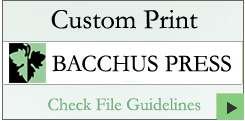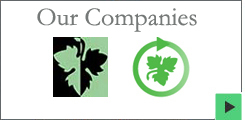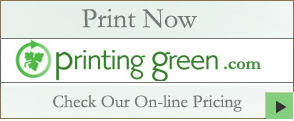Glossary of Printing Terminology
The following printing terms are some of the more common in the graphic design and printing industry and are intended to aid in the communication with our clients. Please call us if you have any questions about any terms not listed here.
Binding or Bindery – Process of using glue, wire staples, thread or mechanical clasps to hold pages together.
Bleed – Extension (1/8") of image areas printed beyond the trim size of a sheet or page. This allows the image to spill off the edge of the page.
Blueline – Prepress, photographic proof where all colors are represented by blue image on white paper.
Bond paper – A strong, durable paper especially well suited for writing, duplicating, and office use.
Camera-ready art (or Mechanical) – A paste-up of all design elements and type proofs in position for photomechanical
reproductions.
Coated stock – Paper that has a chemical finish applied after sheet- formation. The finish may be glossy or matte.
Comp (comprehensive) – a rapidly-drawn but high-quality sketch intended for presentation purposes. Traditionally comps are created as quick color sketches done in marker, often used for client presentations especially in advertising and architecture. A comp is usually intended to be a very close approximation to the final production image so that it can easily be evaluated without the ambiguity of a rough sketch.
Copy – In editing and typesetting, all written material. In graphic design and printing, everything to be printed: art, photographs, and graphics, as well as type.
Cover stock – A heavy stock made for the covers of books or brochures, folders, pamphlets.
Dot gain – The amount that an ink halftone dot expands when applied to the surface of a paper. This is usually a factor of the type of press and the absorbency of the paper.
Duotone – An image that uses two different overlapping halftone screens in different spot colors to create a toned effect.
Dummy – Drawing showing layout of type and graphics.
Finish – A term referring to the appearance of the surface of a paper.
Four-Color Process – Technique of printing that uses process colors (cyan, magenta, yellow, and black) to simulate full-color images.
Glossy print – A photographic print, usually a positive, with a slick shiny surface.
Grain – In paper, the direction in which fibers are aligned.
Hairline – Line or gap about the width of a hair: 1/100th of an inch.
Halftone – An irregular pattern of tiny dots that can be used to print a full range of tones. Halftone screens are used to print reproductions of photographs and artwork that are not line art. Multiple halftones are combined in process color to give the illusion of a full-color image.
Hard Copy – Copy on paper, as opposed to on electronic storage.
Impact Printer – A computer-driven mechanical imprinting device where the characters are formed by the ma printer-head key striking a ribbon to imprint the character's image onto a paper.
Ink-Jet Printer – The print head moves across the paper forming characters by spraying dots of ink. Because the ink is contained in replaceable cartridges, ink-jets can print in color. Resolution approaches laser ma printers, and they're nearly silent. Price may be as low as $150. Earlier models used water-soluble ink that would run easily. Newer models use more permanent ink.
Laser Printer – A type of ma printer that utilizes a laser beam to produce an image on a drum. Laser ma printers produce very high-quality print and are very adept at printing graphics. Because laser printers are nonimpact printers, they are much quieter than dot-matrix printers. They are also relatively fast, printing from about 4 to 20 pages of text per minute (ppm).
Line art – Any artwork or type in which there are no gray tones; all image areas are either black or white. Shading may be accomplished by such techniques as stippling or cross-hatching. Line art can be reproduced without using a halftone screen.
Line screen – The frequency, or fineness of a halftone or screen, expressed in lines per inch (lpi). Coarse screens are used where dot gain is high, fine screens where highest quality is required. This is usually a function of the type of printing press and the paper specification. Common values are 85, 100, 120, 133 and 150 lpi.
Moire – Undesirable pattern in halftones and screen tints made with improperly aligned screens. Pronounced "moray".
Monotone – An image that uses a halftone screen printed in a single spot color to create a toned effect.
NCR – No-Carbon-Required. Standard sequence of carbonless paper is: 2 part = white/canary; 3 part = white/canary/pink; 4 part = white/canary/pink/gold.
Offset – The method of traditional printing where ink is applied to paper by first transferring the ink from a printing plate to a set of rollers and then from the rollers onto paper. This indirect or offset method is still the most common type of printing press.
Opacity – That property of paper that minimizes the "show-through" of printing from the opposite side or the next sheet.
Orphan – Single line of type appearing as first line of a column or page.
Perfect Binding – Binding method in which text pages are glued to the book cover along the spine.
Pixel – Acronym for "Picture Element", dot made by a computer, scanner or other digital device.
PMS (Pantone Matching System) – Commonly used initials of Pantone, Inc., trade names for ink colors in that company's color matching system.
Process color – The method of applying color to a printed project that uses only four (4) inks to depict all colors. The four colors are Cyan, Magenta, Yellow and Black. This process is also known as CMYK color.
Register – Fitting of two or more printed images, usually in different colors, in precise alignment with each other.
Saddle Stitch – To bind by stapling sheets together where they fold at the spine.
Screen – A regular pattern of tiny dots that can be used to print a full range of tones.
Self-Mailer – Publication designed to be mailed without an envelope.
Serif – Short line crossing the ends of main strokes of characters in some type families.
Spot color – The method of applying color to a printed project that uses specially mixed inks to depict the color. There are hundreds of these colors and the most common reference system for selecting them is the Pantone Matching System.
Spread – Two pages that face each other.
Tint – Applying ink as a screen to achieve a tone, usually specified as a percentage.
Transparency – A transparent, positive photographic image, usually a full color slide. This is the highest quality art for color scanning.
Trapping – A technique in which adjacent colors slightly overprint each other to avoid white gaps between the colors, should one or more of the inks print out of register.
Trim Marks – Lines showing where to cut edges off paper or cut paper apart after printing.
Trim size – The final size of a printed piece. The untrimmed size may be larger due to bleed.
Turnaround Time – Amount of time needed to complete a job.
Uncoated stock – Paper without any special chemical finish or coating. The most common type of paper used in printing and copying.
Weight – A relative measurement of the heaviness of papers, stated in pounds (lbs). Common weights for copying papers are 20 and 24 lb. writing, for printing papers are 60, 70 and 80 lb. text, and for covers are 65 and 80 lb. cover.
Up – Printing two or three up means printing the identical piece twice or three times in one impression on one sheet of paper.
Varnish – Clear liquid applied like ink to paper on press to protect and enhance underlying printing.
Weight – For paper, the weight in pounds of a ream of paper cut to the basic size for its grade.
White Space – Designer term referring to non-image area that frames or sets off copy.
Widow – Partial of objectionably short whole word appearing as final line in a paragraph.




